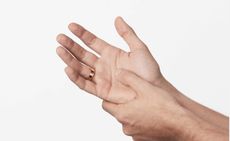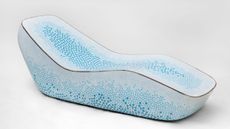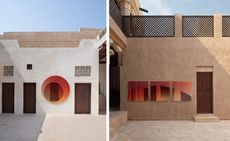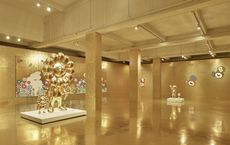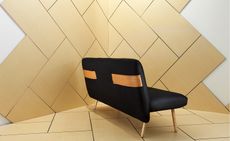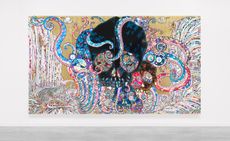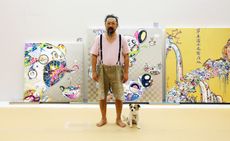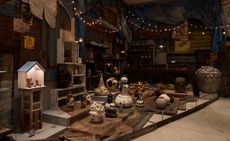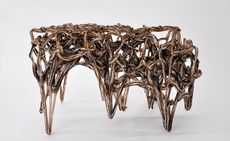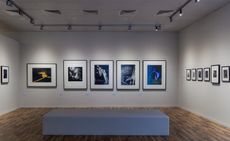Takashi Murakami’s Dubai debut pops with colour, nostalgia and darker undertones
Nadine Khalil interviews Takashi Murakami ahead of his first exhibition in the UAE, at Perrotin’s ICD Brookfield pop-up space, as the gallery also launches its first permanent Middle Eastern outpost
- (opens in new tab)
- (opens in new tab)
- (opens in new tab)
- Sign up to our newsletter Newsletter
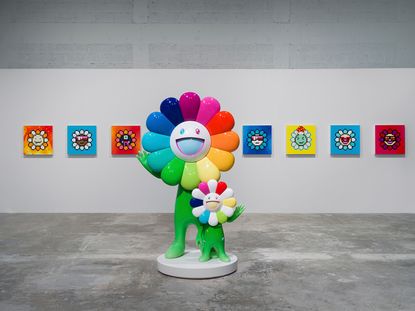
Entering Takashi Murakami’s first exhibition in Dubai feels like visiting a store for hybrid emojis in 3D. On a frontal wall is a new set of heavily pixelated paintings of the artist’s shiny, happy Murakami.Flower series, which have a retro video-game feel. On plinths are DOB sculptures in bow-ties and candy colours (Mr DOB is a prominent mouse-like avatar in the cast of characters the artist created in 1993). In the centre is Together with the Flower Plant and Child featuring two waving plants (one clearly the adult) with wide-mouthed smiles, green bodies and petals the colour of rainbows.
Murakami’s exhibition is taking place at Perrotin’s pop-up space at ICD Brookfield Place, alongside a corresponding show by Jason Boyd Kinsella. It’s part of a partnership with ICD’s Malak Abu-Qaoud and coincides with the launch of Perrotin’s new permanent Middle Eastern outpost, in Dubai’s financial district. The accessibility of Murakami’s visual language paired with Abu-Qaoud’s community-driven approach as an art manager makes this collaboration a good fit.

Takashi Murakami, exhibition view at Perrotin Dubai, ICD Brookfield Place, from 25 November 2022 to 28 January 2023
The wild popularity of the technicolour iterations of Murakami’s DOB works comes from their recognisable references to several animated characters, such as the Japanese robot-cat Doraemon, Sonic the Hedgehog, and Mickey Mouse. ‘I started out as an artist by wanting to draw animations,’ Murakami says. The impact of otaku, or the obsession with video games, manga, animation and science fiction, is ever-present in his work as the kind of Japanese geeky subculture that engenders a major trend. ‘You can really feel the tempo of a place like Japan through its manga culture,’ he continues. ‘When I became a famous artist in New York, I thought I needed to go back to honest, Japanese culture.’ Yet Murakami understood the power of Pop Art early on when he became part of the New York City art scene in the 1990s. His ability to combine this awareness with craft via Nihonga, the lavish Japanese traditional painting technique he studied in university, is how he stakes his claim using the language of consumerism and youthful nostalgia.

Takashi Murakami, exhibition view at Perrotin Dubai, ICD Brookfield Place
Murakami’s ‘Superflat’ ethos of levelled pictorial space and stylised figures has become a signature approach, drawing from kawaii, or the aesthetic of ‘cuteness’ in postwar Japan. This controversial, Neo-Confucian notion of docile, childlike women as illustrations of doe-eyed girls during the Edo period was later popularised by iconic characters such as Hello Kitty. But while the result is that Murakami’s works are often read as emotionally flat, with an optimism that is childlike, a closer look reveals darker undertones in the pointy teeth or refracted faces of DOB Kaiju Monster in the exhibition, undoubtedly inspired by the Japanese kaiju or ‘strange beast’ motif prevalent in a film and TV genre.
Murakami has often explained that Superflat responds to Japan’s post-Second World War condition, earthquakes and the 2011 nuclear disaster in Fukushima. In Dubai, he says, ‘The Japanese people have experienced a lot of natural disasters. Perhaps the [1945] atomic bomb [in Hiroshima and Nagasaki] was seen as that kind of disaster too. At the same time, we still have fear. Maybe my characters look like happiness, but in my head, it’s not necessarily that. There’s this idea hiding in the background.’

Takashi Murakami, exhibition view at Perrotin Dubai, ICD Brookfield Place
His anthropomorphic cartoon-like figures may be an attempt to seek subjects that have been left out of art history, but their rich references are sometimes lost on the viewer. For example, the 108 backgrounds for the Murakami.Flowers series are based on the Buddhist principle of bonnō – or the number of earthly temptations that sully the mind. To an uninformed eye, this could read as the 108 colours of advertising.
The most striking work in the exhibition is on the way out: a 2017 miniature model of Murakami himself, cloaked in an Oriental robe, each hand taking on a mudra (a yogic gesture symbolic in Hindu and Buddhist ritual). Murakami Mini Arhat, modelled on the clairvoyant disciples of the Buddha, is a satirical self-portrait that has Murakami’s face split in two with a double emerging in between. Four eyes imply 360-degree vision and the eerie omniscience of an artist who has long understood the intersections between art and commerce.

Takashi Murakami, exhibition view at Perrotin Dubai, ICD Brookfield Place
Takashi Murakami at Perrotin Dubai, ICD Brookfield Place, until 28 January 2023. perrotin.com (opens in new tab)
-
 Men’s engagement rings for modern grooms
Men’s engagement rings for modern groomsMen’s engagement rings, whether classic or colourful, make for sentimental tokens
By Hannah Silver • Published
-
 Longchamp unites with D’heygere on a playful collection made to ‘transform the everyday’
Longchamp unites with D’heygere on a playful collection made to ‘transform the everyday’Inspired by Longchamp’s foldaway ‘Le Pliage’ bag, this collaboration with Paris-based jewellery and accessories designer Stéphanie D’heygere sees pieces that ‘transform and adapt’ to their wearer
By Jack Moss • Published
-
 Last chance to see: Marc Newson’s all-blue designs in Athens
Last chance to see: Marc Newson’s all-blue designs in AthensGagosian gallery Athens presents new blue furniture and objects by Marc Newson
By Rosa Bertoli • Published
-
 Gallery Collectional launches during Dubai Design Week
Gallery Collectional launches during Dubai Design WeekThe new gallery in Dubai’s Eden House opens with inaugural exhibition ‘The Shape of Things to Come’ and unveils new mirrors by Sabine Marcelis
By Hannah Silver • Last updated
-
 Takashi Murakami goes for gold in immersive Hong Kong show
Takashi Murakami goes for gold in immersive Hong Kong showFrom monumental sculptures to floral fantasies, step into the Japanese art star’s hypersaturated universe at Tai Kwun Contemporary
By Catherine Shaw • Last updated
-
 Unearthing the cultural stories and emotional forces behind Emirati design
Unearthing the cultural stories and emotional forces behind Emirati designBy Suzanne Trocmé • Last updated
-
 Birthday buzz and secret messages at Takashi Murakami retrospective
Birthday buzz and secret messages at Takashi Murakami retrospectiveBy Hadani Ditmars • Last updated
-
 Man at work: rigour, neurochemicals and 24/7 assistants at Takashi Murakami’s studio
Man at work: rigour, neurochemicals and 24/7 assistants at Takashi Murakami’s studioBy Jens Jensen • Last updated
-
 Pot luck: Takashi Murakami’s vast ceramics collection goes on display in Japan
Pot luck: Takashi Murakami’s vast ceramics collection goes on display in JapanBy Charlotte Jansen • Last updated
-
 Middle East revealed: W* explores Dubai's growing design scene
Middle East revealed: W* explores Dubai's growing design sceneBy Suzanne Trocmé • Last updated
-
 Photo finish: Dubai hosts inaugural photography exhibition
Photo finish: Dubai hosts inaugural photography exhibitionBy Kate Barrett • Last updated
